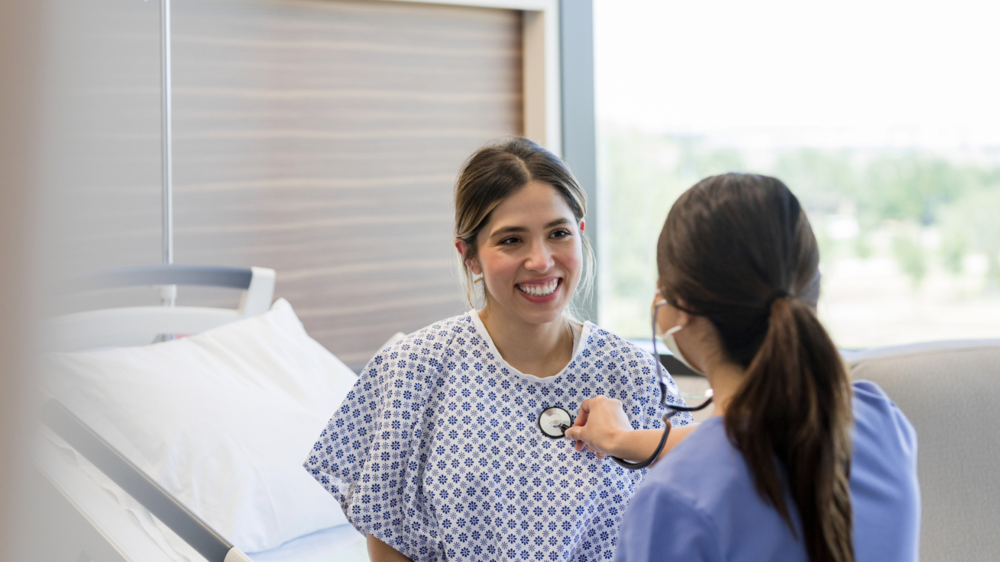In this article:
What is Chorionic Villus Sampling (CVS)?
Chorionic villus sampling is a test performed during pregnancy to check for chromosomal abnormalities or specific genetic disorders in your baby. It involves taking a small sample of tissue from the placenta, which contains tiny projections called chorionic villi. These villi share the same genetic material as your baby, so testing them can reveal important information about your baby’s health. The sample is then sent to a laboratory for analysis. This procedure can help identify conditions like Down syndrome or other genetic issues.- When it’s done: Usually between 11 and 13 weeks of pregnancy.
- What it tests for: Chromosomal abnormalities (e.g. extra or missing chromosomes) and specific genetic disorders like thalassemia or sickle cell disease, depending on family history and available lab tests.
Why Might You Need Chorionic Villus Sampling?
Your healthcare professional may recommend CVS if there’s a higher chance your baby could have a genetic or chromosomal condition. It’s not a routine test, so it’s only offered in specific situations. You can choose whether to have it after discussing the risks and benefits with your doctor.Need for Chorionic Villus Sampling
- You or your partner has a family history of a genetic disorder, such as thalassemia or muscular dystrophy.
- You’ve had a previous child with a genetic condition.
- A first-trimester ultrasound or screening test (like a cell-free DNA test) shows abnormal results.
- There’s a risk of a sex-linked genetic disease.
- You want to confirm or rule out specific conditions based on your medical or family history.
When it’s not recommended
- If you’ve had vaginal bleeding during pregnancy.
- If you have an active infection, such as a sexually transmitted infection (STI).
Preparing for Chorionic Villus Sampling
Preparing for CVS includes some basic steps to help the procedure go as planned. Your healthcare professional will guide you through the process, but here’s what you can expect before the procedure:- You’ll have a discussion with your doctor or a genetic counsellor about why the test is recommended, its risks, and benefits.
- You’ll need to sign a consent form after understanding the procedure fully.
- Inform your doctor about any allergies (e.g. to latex, iodine, or anaesthetics) or medications you’re taking, especially blood thinners, as you may need to stop these beforehand.
- Your blood group will be checked, particularly if you’re Rh negative, to prevent complications like Rh sensitisation.
- You may have an ultrasound to confirm your pregnancy stage and check the baby’s heart rate and placenta position.
- Depending on your uterus and placenta position, you might be asked to have a full or empty bladder for the procedure.
What Happens During the Procedure?
CVS is generally carried out on an outpatient basis, meaning you can go home the same day. You’ll change into a hospital gown and lie on an examination table. Your vital signs (blood pressure, heart rate, breathing rate) will be monitored.There are two ways to perform CVS, depending on the position of your placenta and your anatomy. Ultrasound is used in both methods to guide the procedure and keep the baby safe.
Transcervical Chorionic Villus Sampling
- A speculum is inserted into your vagina to view the cervix.
- Your vagina and cervix are cleaned with an antiseptic solution.
- A thin plastic tube is guided through the cervix to the placenta to collect a small sample of chorionic villi using gentle suction.
- You might feel a twinge or mild cramping during this process.
Transabdominal Chorionic Villus Sampling
- Your abdomen is cleaned with an antiseptic.
- A local anaesthetic may be used to numb the skin, which might cause a brief stinging sensation.
- A thin, hollow needle is inserted through your abdomen and uterus to the placenta to collect the tissue sample.
- You may feel slight discomfort or cramping as the needle enters the uterus.
After the Procedure
Once the procedure is complete, you and your baby will be monitored for a short time before you head home.- You may experience mild cramping, light vaginal spotting, or slight soreness at the needle site (for transabdominal CVS).
- Rest for a few hours after the procedure. You can resume normal activities the next day, but your doctor may suggest resting at home for up to 3 days to reduce infection risk.
- Your doctor may advise avoiding sex or douching for at least 2 weeks.
Risks of Chorionic Villus Sampling
CVS procedure does carry some risks. It’s important to discuss these with your doctor to make an informed decision. These risks may include:- Miscarriage.
- Infection.
- Light bleeding or spotting.
- Leaking amniotic fluid, which could lead to complications.
- Limb deformities in the baby (very rare, especially if done before 10 weeks).
- Rh sensitisation if you’re Rh negative and the baby is Rh positive.
- Inadequate sample or culture failure, which may require a repeat CVS or amniocentesis.
- Mosaicism, when a person has two or more groups of cells with different genetic makeups in their body. This happens due to a genetic change that occurs after fertilisation.
Factors that may complicate chorionic villus sampling
- Pregnancy that is earlier than 7 weeks or later than 13 weeks of gestation.
- Position of the baby, placenta, or low amniotic fluid levels.
- Vaginal or cervical infections.
- Samples that may contain maternal tissue.
Chorionic Villus Sampling Results
The tissue sample from CVS is sent to a lab for genetic analysis, and results take different amounts of time depending on the tests performed. The result timelines are as follows:- Preliminary results (e.g. FISH test) are available within 3 days.
- Full karyotype results, which provide a detailed chromosome analysis, take 2 to 3 weeks.
- Other genetic tests may take 7 to 10 days.
What Results Mean
- If results show a genetic condition, your doctor will discuss what this means and your options, such as preparing for a baby with special needs.
- In rare cases, results may show abnormalities in the placenta but not the baby. This may require further testing, like amniocentesis, to confirm.
When to Contact Your Healthcare Professional
Seek medical support immediately if you experience any of the symptoms mentioned below:- Heavy vaginal bleeding or leaking amniotic fluid.
- Fever, chills, or severe abdominal pain.
- Persistent cramping or soreness that worsens.
- Any fluid leaking from the needle site (for transabdominal CVS).
Questions to Ask Your Healthcare Professional
If you’re advised CVS testing, it’s helpful to have an open conversation with your doctor. These are some questions to ask:- Am I at high risk of having a baby with a genetic or chromosomal condition?
- What specific conditions will CVS test for in my case?
- What are the risks of miscarriage or other complications for me?
FAQs on Chorionic Villus Sampling (CVS): Detecting Foetal Genetic Disorders During Early Pregnancy
- When is the ideal time to have chorionic villus sampling done?
CVS is typically performed between 10 and 13 weeks of pregnancy. - What conditions can chorionic villus sampling detect?
It can detect conditions such as Down syndrome, thalassemia, sickle cell disease, and other genetic disorders, depending on the testing. - Is chorionic villus sampling a routine test for all pregnant individuals?
No, it is usually recommended only if there is a higher risk of genetic disorders.






